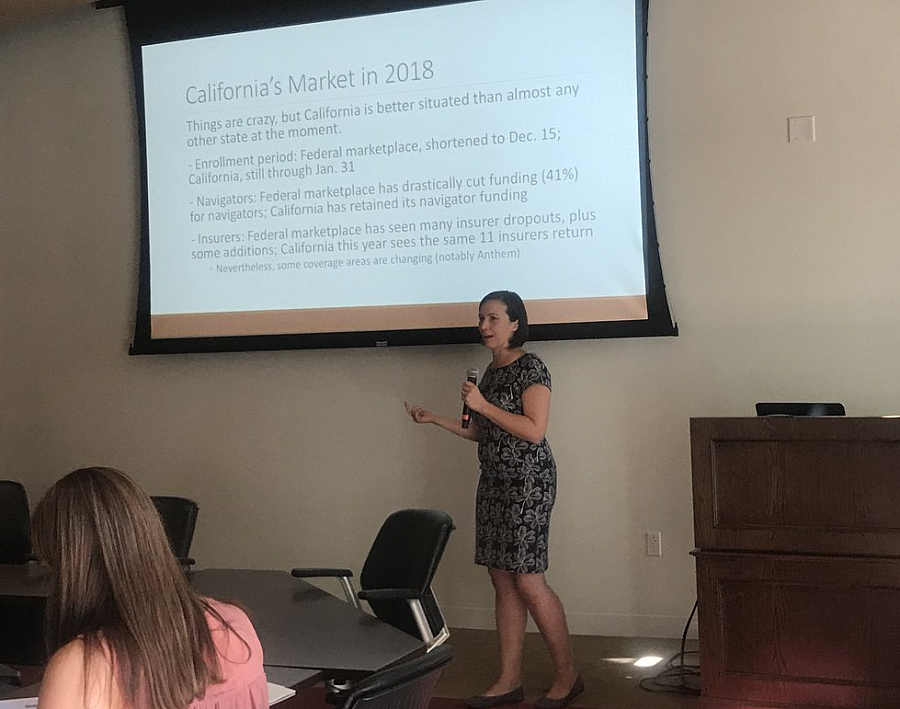How California’s embrace of the ACA will help it endure latest attacks on law

Meghan Hoyer talks about stories to track during the upcoming ACA open enrollment season.
The Affordable Care Act’s fifth season of open enrollment starts November 1 amid a cloud of confusion and uncertainty. Just how much are premiums going up? What does President Trump’s move to end cost-sharing reductions mean for consumers? And given Trump’s declaration that Obamacare “is dead,” will people still bother to sign-up for insurance?
The ACA may have just barely escaped the GOP’s summer of repeal efforts, but Trump’s ongoing efforts to drive a stake through the ACA by executive fiat will make this an enrollment season unlike any other. As Meghan Hoyer, an AP data editor, told fellows at the 2017 California Data Fellowship this week, the degree of flux swirling around the ACA means a story written yesterday may well be out of date today.
While California has long been seen as a bellwether state by which to gauge the success of the ACA’s rollout, Hoyer told a room full of California journalists that the state’s eager embrace of Obamacare has now left it in a unique position. “California is way better situated to handle a lot of the bumps that are happening right now than pretty much any other state,” Hoyer said.
Many of the reasons for that are simple. The federal marketplace curtailed the open enrollment period so that it now ends on December 15, while enrollment on the California exchange still runs through January 31. The Trump Administration cut federal funding for the navigators who help people enroll in coverage by 41 percent for 2017; California has kept them fully funded. The federal marketplace has seen a number of insurers drop out, while California has kept the same 11 insurers from last year. The federal marketplace cut its advertising budget by 90 percent; California didn’t cut its ad budget.
That doesn’t mean California is immune from all the challenges facing the other ACA exchange markets. Trump’s decision to pull the plug on the ACA’s cost-sharing reduction payments (CSRs) means that silver-tier plans will have an average surcharge of 12.4 percent tacked on to them. But that’s an average: Depending on the state and insurer, premiums for silver plans will go up from 7 to 38 percent, according to a new report released by the Kaiser Family Foundation on Friday.
Since the ACA’s federal subsidies are tied to the second-least expensive silver plan, most people will see little change in the cost of their premiums — as long as they qualify for subsidies. The federal government will largely end up paying the cost difference, since the subsidies increase as the premiums go up. But for people buying unsubsidized silver plans, they could be in for a painful financial hit if they don’t bother to shop for new coverage.
“If you’re unsubsidized and you’re in that silver tier plan and you’re not active in getting off your silver tier plan with this big surcharge on it, you’re going to see your costs go way up,” Hoyer said.
In some states, insurers will offer plans that are essentially identical to silver-level exchange plans, but they will be sold off the exchange, so they won’t incur the CSR surcharge tacked onto silver exchange plans. Or consumers may choose to switch to bronze or gold-tier plans, some of which will now be cheaper than silver plans. But this kind of strategizing assumes a savvy, informed shopper.
“There’s a lot of fear this year about people who are going to be passive consumers versus active consumers,” Hoyer said. “If you’re not an active consumer this year, you could face real serious problems in the sense that you could be suddenly faced with an entirely different doctor network, you could be faced with a narrow network, or you could be faced with these really large surcharges.”
But while monitoring the fate of those with unsubsidized silver-level plans is a solid story to follow in your coverage area, there’s an even more basic story journalists will want to track starting in November.
“As the open enrollment season starts, you’re going to really want to watch out for [whether] interest [is] down?” Hoyer said. “Are people shying away from (enrolling) because they don’t understand what’s happening?”
If people in need of health insurance think the ACA is dead or dying based on the political fight over gutting the law, that will throw a huge wrench into the health exchange market.
“Are people in your area really confused about whether this thing even exists?” Hoyer asked.
**

